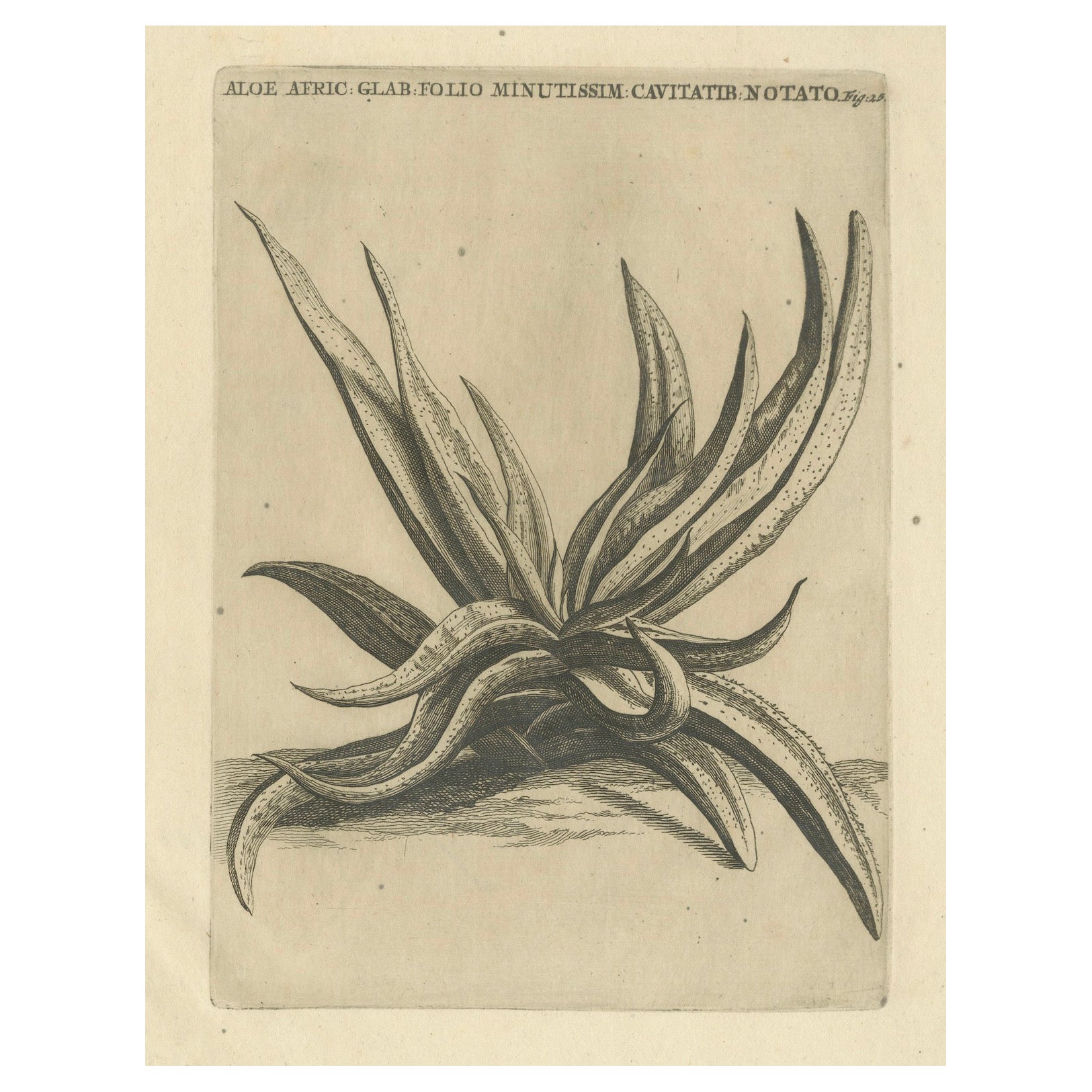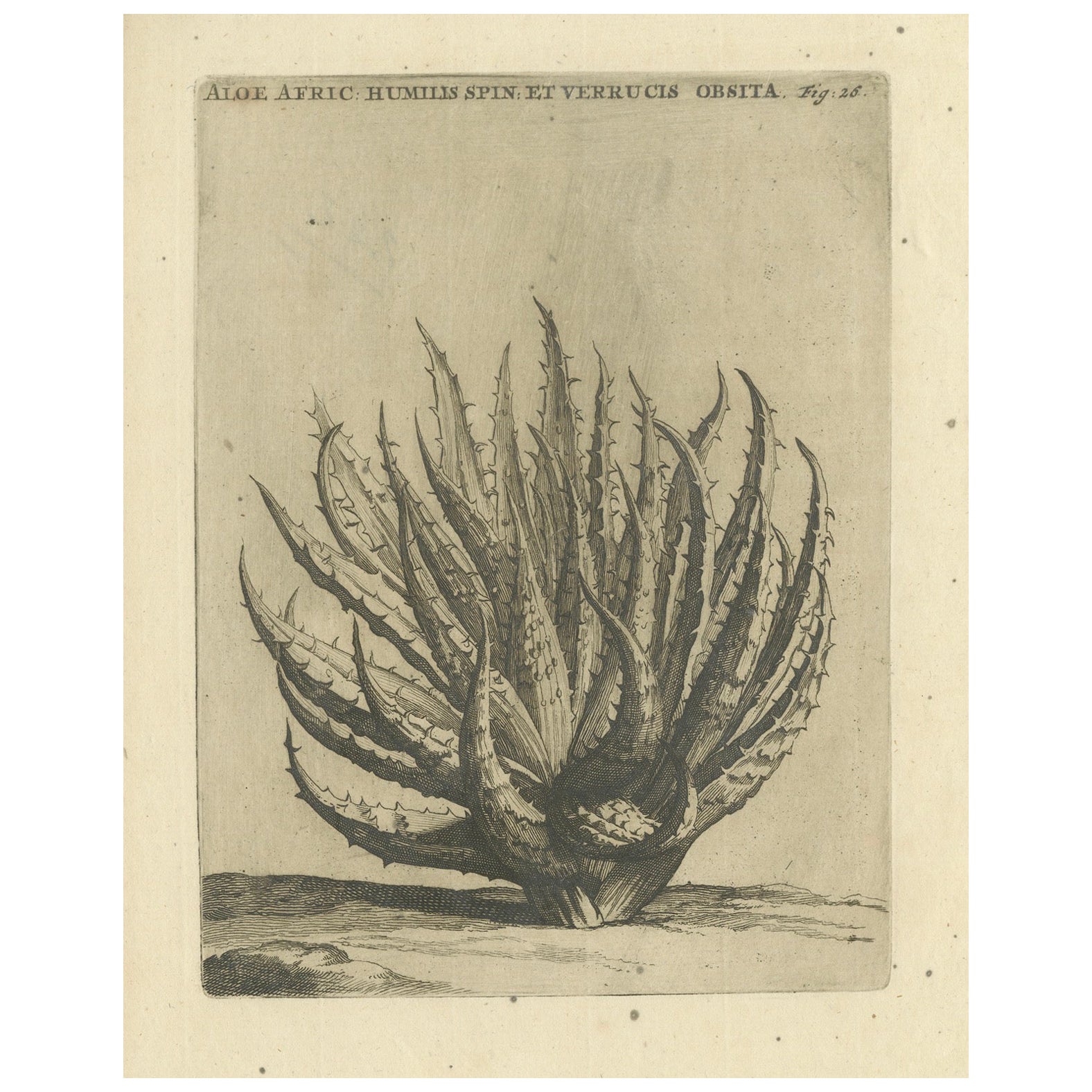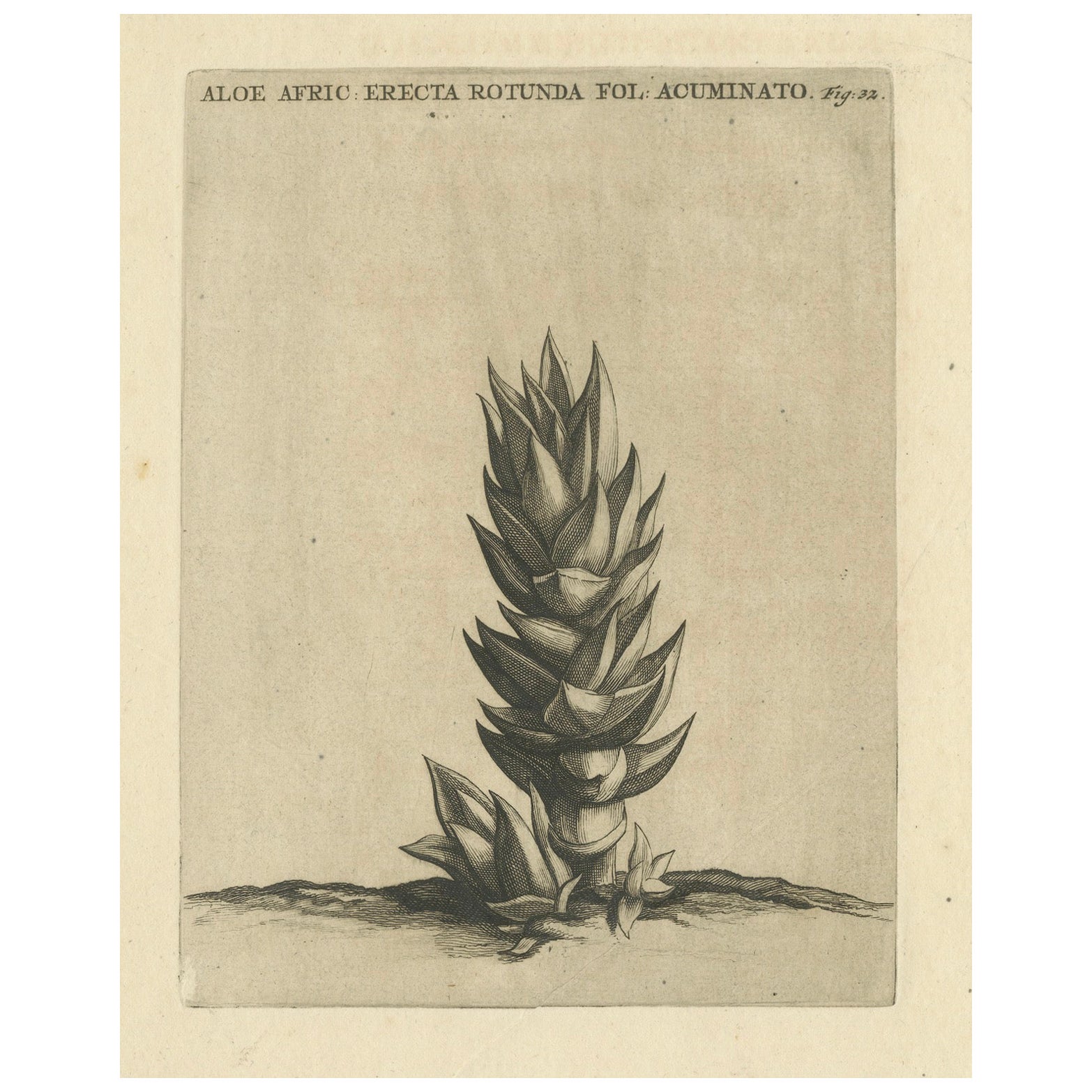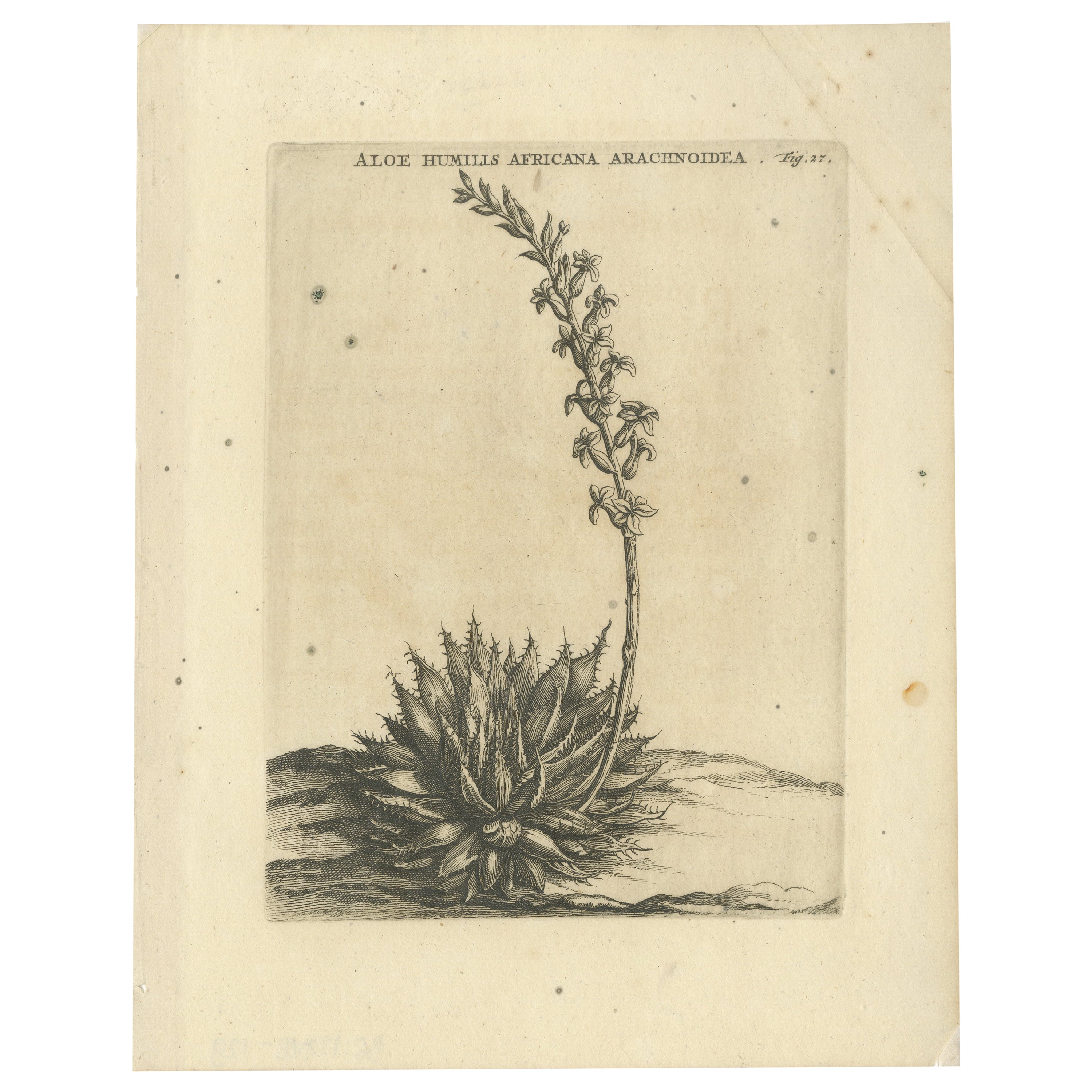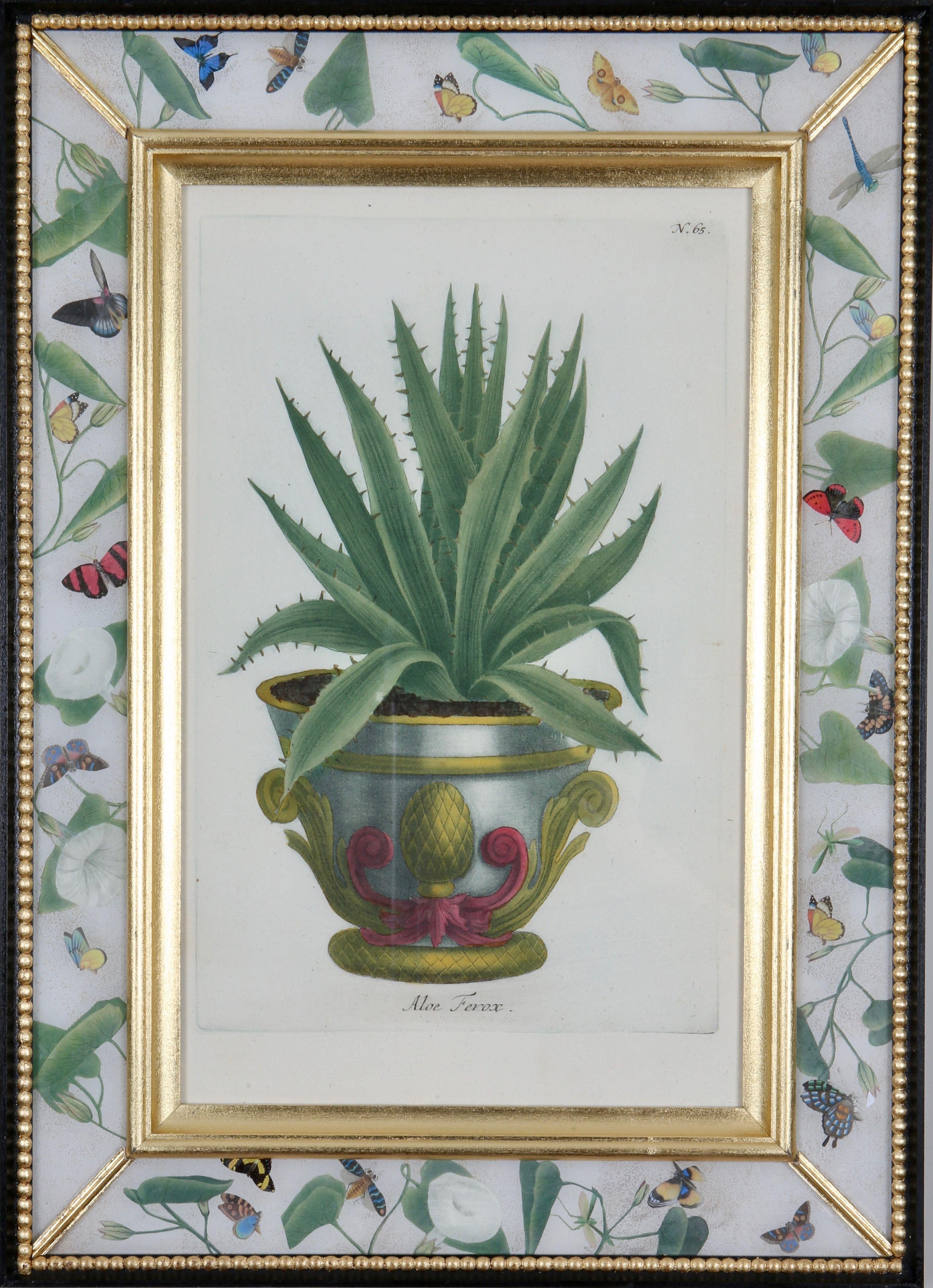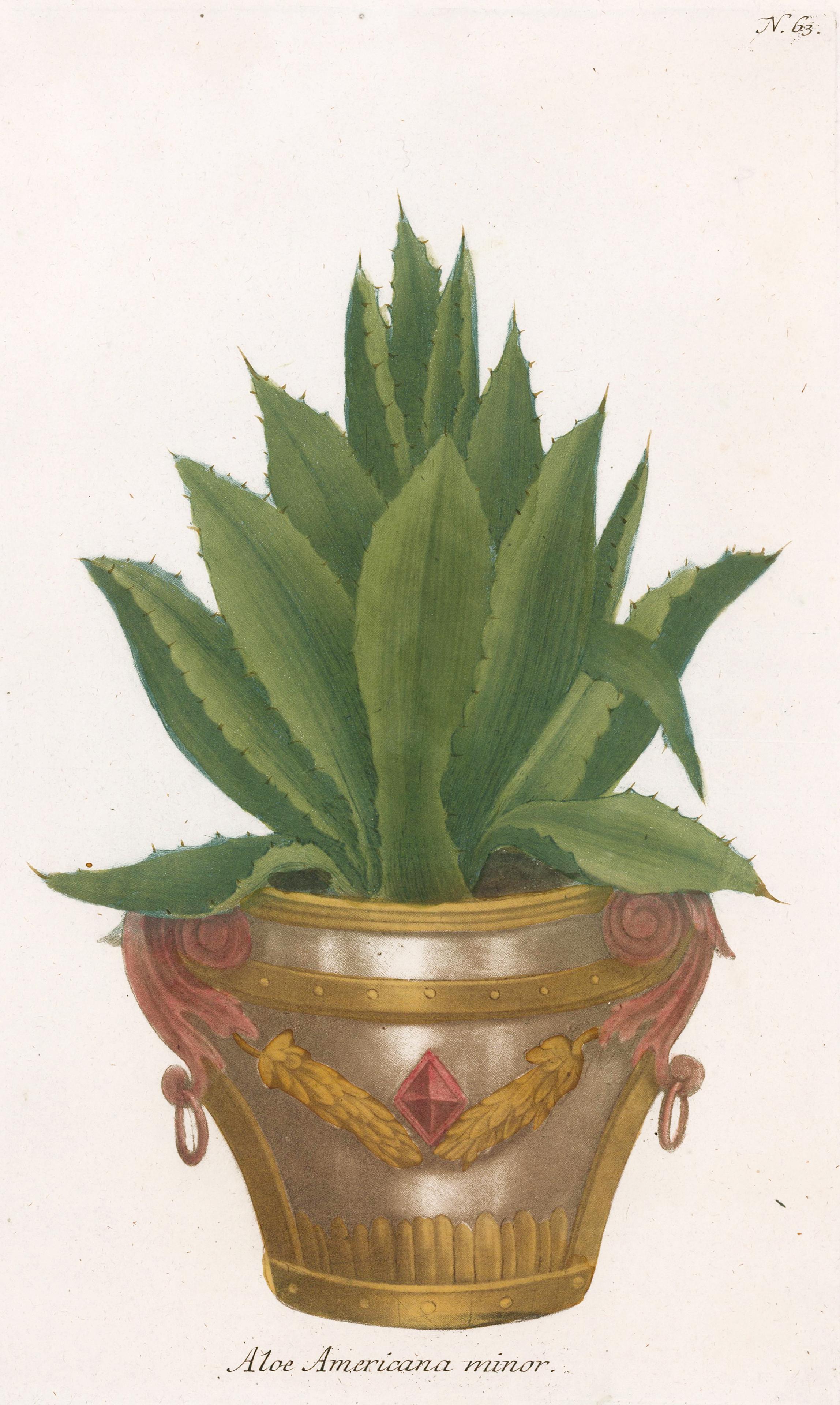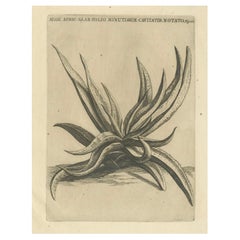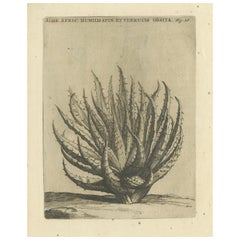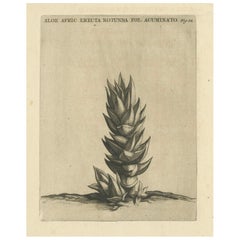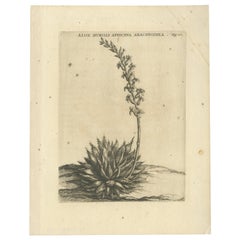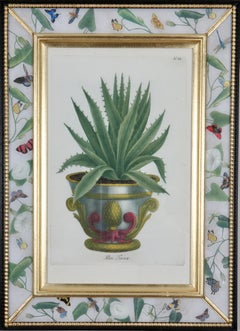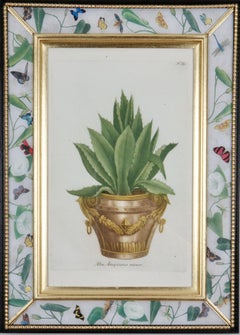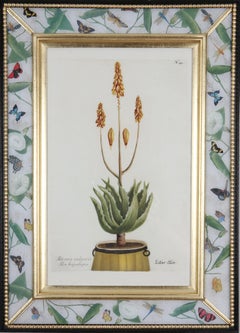Items Similar to Caulescent African Aloe from Caspar Commelin’s "Praeludia Botanica" - 1703
Want more images or videos?
Request additional images or videos from the seller
1 of 8
Caulescent African Aloe from Caspar Commelin’s "Praeludia Botanica" - 1703
$326.67
$408.3420% Off
£240.59
£300.7420% Off
€272
€34020% Off
CA$444.41
CA$555.5120% Off
A$493.83
A$617.2920% Off
CHF 258.77
CHF 323.4720% Off
MX$6,055.99
MX$7,569.9920% Off
NOK 3,300.51
NOK 4,125.6420% Off
SEK 3,105
SEK 3,881.2520% Off
DKK 2,070.69
DKK 2,588.3720% Off
Shipping
Retrieving quote...The 1stDibs Promise:
Authenticity Guarantee,
Money-Back Guarantee,
24-Hour Cancellation
About the Item
This engraving is a botanical illustration possibly from Caspar Commelin's "Praeludia Botanica," published in 1703. It depicts the Aloe ferox, a species of African aloe, known for its large, spiny leaves. The engraving is titled in Latin, Aloe Afric: Caulesc: Fol: Glauc: Caulem Amplect: Spinos," which translates to "Caulescent African Aloe, broad, clasping, spiny leaves."
This engraving is potentially a proof print of Caspar Commelin's work, "Horti Medici Amstelaedamensis Plantæ Rariores et Exoticæ ad Vivum Æri Incisæ," published in 1706 by Fredericum Haringh in Leiden (Lugduni Batavorum).
The style, botanical detail, and Latin labeling in the engraving align with the scientific and illustrative approach typical of the Commelins' botanical works. The use of detailed plant illustrations in their publications, engraved directly from life ("ad vivum"), aimed to document the rare and exotic plants housed at the Amsterdam Hortus Medicus.
Given that proof prints were often created to check the quality and accuracy of engravings before the final prints were included in a published work, this piece could be part of the preparatory stages of Commelin’s famous botanical publications. The 1706 edition of Caspar Commelin's work, following Jan Commelin's earlier efforts, fits the timeline and the subject matter of this engraving.
The illustration matches the descriptions and layout found in the final published works, so it is likely a proefdruk from the "Horti Medici Amstelaedamensis" or a related botanical collection.
Jan Commelin, a 17th-century medical doctor and director of botany at the Amsterdam Hortus Medicus, was a pioneering figure in the classification of exotic plants sent from distant regions. He authored the influential "Horti Medici Amstelodamensis Rariorum," published in 1697, a work that cataloged rare plants from around the world. After his death, his nephew Caspar Commelin continued and completed the project, contributing to the documentation of over 360 species, including 229 from Africa, 97 from the Americas, and 41 from Asia.
The Commelins are regarded as some of the most important early botanists for their role in cataloging and classifying the newly discovered plant species being brought to Europe during the age of exploration. Their meticulous work laid the foundation for later botanical studies and greatly contributed to the knowledge of global plant biodiversity.
Description: The engraving shows a fully grown aloe plant with thick, pointed leaves arranged in a rosette pattern. The leaves are broad and spiny, curving outward from the base. The plant is set against a simple background, allowing the viewer to focus on the botanical details.
- Leaf Texture: The engraving carefully captures the rough texture and the jagged edges of the aloe’s leaves. Each leaf is spiny, with serrated margins typical of the *Aloe ferox* species.
- Base and Growth Pattern: The base of the plant is well-detailed, showing the attachment of the leaves to the stem. The illustration emphasizes the caulescent (stem-forming) nature of the plant, with leaves growing from the central axis.
The coloring of the illustration, with shades of green and subtle highlights, indicates that this is a hand-colored engraving, a common practice for botanical works during the 17th and 18th centuries to give a more lifelike representation of the plants.
Maker: The engraving is part of Caspar Commelin's "Praeludia Botanica," a work that documents exotic and rare plants. Commelin was a botanist based in the Netherlands and worked in the botanical gardens of Amsterdam. His works focused on the study and documentation of exotic plants brought back to Europe by Dutch traders and explorers. The illustrations in this book were engraved with great care to serve as both scientific documentation and visual art.
What It Shows: This engraving illustrates the Aloe ferox, an African species known for its medicinal properties. The aloe is native to South Africa and has been used for centuries for its healing qualities, particularly for its sap, which has soothing and laxative effects. The detailed illustration is meant to show both the aesthetic and botanical features of the plant, such as its spiny leaves and succulent structure.
This engraving would have been an important reference for European botanists and herbalists in the 18th century, as they sought to categorize and understand the medicinal and economic potential of plants brought from the colonies and distant lands.
- Dimensions:Height: 9.34 in (23.7 cm)Width: 7.29 in (18.5 cm)Depth: 0 in (0.02 mm)
- Materials and Techniques:Paper,Engraved
- Period:1700-1709
- Date of Manufacture:1703
- Condition:Condition: very good, given age. Etching / engraving on hand-laid (verge) paper. Light foxing, mostly outside the plate-mark. Original coloring. General age-related toning and/or occasional minor defects from handling. Please study scan carefully.
- Seller Location:Langweer, NL
- Reference Number:Seller: BG-13748-1201stDibs: LU3054341523142
About the Seller
5.0
Recognized Seller
These prestigious sellers are industry leaders and represent the highest echelon for item quality and design.
Platinum Seller
Premium sellers with a 4.7+ rating and 24-hour response times
Established in 2009
1stDibs seller since 2017
2,494 sales on 1stDibs
Typical response time: 1 hour
- ShippingRetrieving quote...Shipping from: Langweer, Netherlands
- Return Policy
Authenticity Guarantee
In the unlikely event there’s an issue with an item’s authenticity, contact us within 1 year for a full refund. DetailsMoney-Back Guarantee
If your item is not as described, is damaged in transit, or does not arrive, contact us within 7 days for a full refund. Details24-Hour Cancellation
You have a 24-hour grace period in which to reconsider your purchase, with no questions asked.Vetted Professional Sellers
Our world-class sellers must adhere to strict standards for service and quality, maintaining the integrity of our listings.Price-Match Guarantee
If you find that a seller listed the same item for a lower price elsewhere, we’ll match it.Trusted Global Delivery
Our best-in-class carrier network provides specialized shipping options worldwide, including custom delivery.More From This Seller
View AllBotanical Engraving of African Aloe from Commelin’s "Praeludia Botanica", 1703
Located in Langweer, NL
African Aloe Botanical Engraving from Caspar Commelin’s "Horti Medici Amstelaedamensis," 1706
This engraving is possibly a botanical illustration from Caspar Commelin's "Praeludia B...
Category
Antique Early 1700s Prints
Materials
Paper
$278 Sale Price
20% Off
Aloe Afric Humilis Botanical Engraving from Caspar Commelin’s Work, 1706
Located in Langweer, NL
Aloe Afric Humilis Botanical Engraving from Caspar Commelin’s Work, 1706
This engraving is possibly a botanical illustration from Caspar Commelin's "Praeludia Botanica," published i...
Category
Antique Early 1700s Prints
Materials
Paper
$278 Sale Price
20% Off
Botanical Engraving of Aloe Afric Erecta from Caspar Commelin's Work, 1706
Located in Langweer, NL
Botanical Engraving of Aloe Afric Erecta from Caspar Commelin's Work, 1706
This engraving is likely a botanical illustration from Caspar Commelin's "Praeludia Botanica," published i...
Category
Antique Early 1700s Prints
Materials
Paper
$278 Sale Price
20% Off
Aloe Humilis Africana Botanical Engraving from Caspar Commelin's Work, 1706
Located in Langweer, NL
Aloe Humilis Africana Botanical Engraving from Caspar Commelin's Work, 1706
This engraving is possibly a botanical illustration from Caspar Commelin's "Praeludia Botanica," publishe...
Category
Antique Early 1700s Prints
Materials
Paper
$278 Sale Price
20% Off
Original Antique Botany Print of Bulbine Cepacea, 'South Africa', 1812
Located in Langweer, NL
Description: Antique botany print of Bulbine Cepacea, a flowering plant in the genus Bulbine endemic to South Africa, the Western Cape province. This prin...
Category
Antique 1810s Prints
Materials
Paper
$129 Sale Price
20% Off
Antique Print of the Pineapple Flower or Pineapple Lily or Wine Eucomis, 1806
Located in Langweer, NL
Antique botany print of Eucomis Comosa, also known as pineapple flower, pineapple lily or wine eucomis.
This print originates from 'Curtis's botanical magazine'.
Artists and Engr...
Category
Antique Early 1800s Prints
Materials
Paper
$230 Sale Price
20% Off
You May Also Like
Johann Weinmann: 18th Century Engraving. Aloe in a Decorative pot.
Located in Richmond, GB
PRICE IS FOR EACH FRAMED PRINT.
Hand-coloured mezzotint engravings of decorative urns with aloes and cacti from: ""Phytanthoza Iconographia"", c1739, presented in hand- made, parce...
Category
18th Century Figurative Drawings and Watercolors
Materials
Watercolor, Mezzotint
Aloe Plant Engraving
By Johann Wilhelm Weinmann
Located in New York, NY
Original engraving by Johann Wilhelm Weinmann from "Phytanthosa Iconographia." Ratisbon, 1737-1745.
This plate: N. 304 Caranna.[Palm Tree].
Mezzotint engraving printed in color and f...
Category
Early 18th Century Prints and Multiples
Materials
Laid Paper
Johann Weinmann: 18th Century Engraving of an aloe in a decorative pot.
Located in Richmond, GB
Hand-coloured mezzotint engravings of decorative urns with aloes and cacti from: ""Phytanthoza Iconographia"", c1739, presented in hand- made, parcel-gilt, ebonised and decalcomania...
Category
18th Century Figurative Drawings and Watercolors
Materials
Watercolor, Mezzotint
Johann Weinmann: 18th Century Engraving of an aloe in a decorative pot.
Located in Richmond, GB
Hand-coloured mezzotint engravings of decorative urns with aloes and cacti from: ""Phytanthoza Iconographia"", c1739, presented in hand- made, parcel-gilt, ebonised and decalcomania...
Category
18th Century Figurative Drawings and Watercolors
Materials
Watercolor, Mezzotint
Johann Weinmann: 18th Century Engraving of an aloe in a decorative pot.
Located in Richmond, GB
PRICE IS FOR EACH FRAMED ITEM. MORE EXAMPLES AVAILABLE
Hand-coloured mezzotint engravings of decorative urns with aloes and cacti from: ""Phytanthoza Iconographia"", c1739, present...
Category
18th Century Figurative Drawings and Watercolors
Materials
Watercolor, Mezzotint
Johann Weinmann: 18th Century Engraving of an aloe in a decorative pot.
Located in Richmond, GB
Hand-coloured mezzotint engravings of decorative urns with aloes and cacti from: ""Phytanthoza Iconographia"", c1739, presented in hand- made, parcel-gilt, ebonised and decalcomania...
Category
18th Century Figurative Drawings and Watercolors
Materials
Watercolor, Mezzotint
More Ways To Browse
Dovetail Vinyl Record
Dragon Boat
Egyptian Cat
Embossed Copper Box
English Bow Front Chest
English Headboard
English Iron Bed
Folding Travel Clock
Fornasetti Paper
Four Poster Bed Kings
Francois Pompon
Franz Xavier Bergman
Frem Rojle Chair
French Confit Jar
French Opaline Bottle
French Soda
Garden Rabbit
German Cigarette Case
